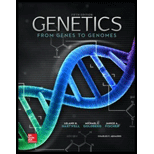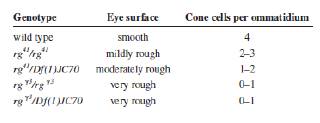
Concept explainers
In 1932, H. J. Muller suggested a genetic test to determine whether a particular mutation whose phenotypic effects are recessive to wild type is a null (amorphic) allele or is instead a hypomorphic allele of a gene. Muller’s test was to compare the
In a study using Muller’s test, investigators examined two recessive, loss-of-function mutant alleles of rugose named rg41 and rgγ3 . The eye morphologies displayed by flies of several genotypes are indicated in the following table. Df(1) JC70 is a large deletion that removes rugose and several genes to either side of it.

| a. | Which allele (rg41 or rgγ3) is stronger (that is, which causes the more severe mutant phenotype)? |
| b. | Which allele directs the production of higher levels of functional Rugose protein? |
| c. | How would Muller’s test discriminate between a null allele and a hypomorphic allele? Suggest a theoretical explanation for Muller’s test. Based on the results shown in the table, is either of these two mutations likely to be a null allele of rugose? If so, which one? |
| d. | Explain why an investigator would want to know whether a particular rg allele was amorphic or hypomorphic. |
| e. | Suppose that a hypermorphic rg allele exists (rghyper) that causes rough eyes due to an excess of cone cells. Could you use Muller’s genetic method to determine that the dominant allele is hypermorphic? Explain. |
| f. | Suppose an antimorphic rg allele exists (rganti). Can you think of a way to determine if a dominant mutation is antimorphic? (Hint: Assume that in addition to the chromosome with a deletion that deletes rg, a chromosome with a duplication that includes the wild-type rg gene is available.) |
Trending nowThis is a popular solution!

Chapter 18 Solutions
Genetics: From Genes to Genomes, 5th edition
- Familial retinoblastoma, a rare autosomal dominant defect, arose in a large family that had no prior history of the disease. Consider the following pedigree (the darkly colored symbols represent affected individuals): a. Circle the individual(s) in which the mutation most likely occurred. b. Is the person who is the source of the mutation affected by retinoblastoma? Justify your answer. c. Assuming that the mutant allele is fully penetrant, what is the chance that an affected individual will have an affected child?arrow_forwardYou are studying four linked genes located on chromosome 2 in the fruit fly Drosophila melanogaster: adp (which contributes to obesity), b (which contributes to body color), pr (which contributes to metabolism), and vg (which contributes to wing formation). A series of crosses between pair-wise combinations of these mutations yielded the following recombination frequencies between the indicated loci: pr and adp 9% adp and b 6% pr and b 3% vg and b 10% vg and pr 7% What is the genetic distance in map units (cM) between the adp and vg loci? 16 9 6 4arrow_forwardA researcher crosses mice with brown eyes and long tails, and the F1 progeny were recovered in the following numbers and phenotypic classes: F1: 6 apricot, short : 30 brown, long : 15 brown, short : 9 apricot, long You know the genes encoding these traits are autosomal, completely dominant and assort independently. You want to use a chi-square test to analyse these results. a) Making use of the appropriate genetic convention for naming alleles, give the genotype of the male parent in this cross. b) What is your null hypothesis for the chi-square test? c) Give the expected number of individuals in the "brown, long" class. d) You obtain a value of 3.47 for the chi-square test. What conclusion can you make from the results of the chi-square test? P df 0.995 0.975 0.9 0.5 0.1 0.05* 0.025 0.01 0.005 1 0.000 0.000 0.016 0.455 2.706 3.841 5.024 6.635 7.879 2 0.010 0.051 0.211 1.386 4.605 5.991 7.378 9.210 10.597 0.072 0.216 0.584 2.366 6.251 7.815 9.348 11.345 12.838 4 0.207 0.484 1.064 3.357…arrow_forward
- Duchenne muscular dystrophy is an X-linked, recessive disorder in which muscles waste away early in life, resulting in death in the teens or twenties. A man and woman in their late thirties have five children—three boys (ages 1, 3, and 10 years) and two girls (ages 5 and 7 years). The oldest, boy shows symptoms of the disease. What are the probabilities that their other children will develop the disease? Give only typing answer with explanation and conclusionarrow_forwardRed eyes (r), brown color (b), and curled wings (c) are 3 recessive mutations that occur in house flies. These genes have already been mapped: r-b = 12 mu b-c = 18 mu r-c = 30 mu A fly with red eyes, brown color, and curled wings is crossed with a fly homozygous for the wild-type traits. The F1 males are crossed with females with the three mutant traits and 2000 progeny are produced. Find the number of observed double crossovers if the interference is 0.38. O 43 O 62 O 27 O 16arrow_forwardSix months pregnant, an expectant mother had a routine ultrasound that showed that the limbs of the fetus were unusually short. Her physician suspected that the baby might have a genetic form of dwarfism called achondroplasia, an autosomal dominant trait occurring with a frequency of about 1 in 27,000 births. The parents were directed to a genetic counselor to discuss this diagnosis. In the conference, they learned that achondroplasia is caused by a mutant allele. Sometimes it is passed from one generation to another, but in 80 percent of all cases it is the result of a spontaneous mutation that arises in a gamete of one of the parents. They also learned that most children with achondroplasia have normal intelligence and a normal life span. 1. What information would be most relevant to concluding which of the two mutation origins, inherited or new, most likely pertains in this case? How does this conclusion impact on this couple’s decision to have more children? 2. It has been…arrow_forward
- The wild-type (normal) fruit fly, Drosophila melanogaster, has straight wings and long bristles. Mutant strains have been isolated that have either curled wings or short bristles. The genes representing these two mutant traits are located on separate chromosomes. Carefully examine the data from the following five crosses shown below (running across both columns). (a) Identify each mutation as either dominant or recessive. In each case, indicate which crosses support your answer. (b) Assign gene symbols and, for each cross, determine the genotypes of the parents.arrow_forwardTwo related forms of muscular dystrophy—Duchenne muscular dystrophy (DMD) and Becker muscular dystrophy (BMD)—are both recessive, X-linked, single-gene conditions caused by point mutations, deletions, and insertion in the dystrophin gene. Each mutated form of dystrophin is one allele. Of the two diseases, DMD is much more severe. Given your knowledge of mutations, the genetic code, and translation, propose an explanation for why the two disorders differ greatly in severity.arrow_forwardConsider the first category of test-cross offspring shown in figure 8.2 (+b, LS). Consider also that the parents of the heterozygous female flies in the test cross had the following genotypes: bb, SS, and +, LL. A. What would be the physical phenotype of these flies? B. If PC was conducted with the DNA of one of these flies using the primers for the molecular marker, what would be the appearance of the bands on an electrophoresis gel with the PC products? C. If the gene for black body and the locus for the molecular marker (L long or S short) were unlinked, what proportion of the test-cross progeny would be black flies that are heterozygous for the molecular marker? What proportion would be flies with normal body color, which are homozygous for one form of the molecular marker? D. If the gene for black body and the locus for the molecular marker were linked, how would the proportion of flies be different?arrow_forward
- Concordance studies of twins for a neurodegenerative disorder show MZ= 46% and DZ= 15%. Further studies have shown a possible link to a gene on chromosome 9, however, there are some individuals in the study who have the allele but do not develop the disorder (group 1), and there are other individuals who do not have the allele yet develop the disorder (group 2). Amita's older sister and maternal uncle have this disorder. Currently, Amita & her 2 younger brothers do not show symptoms. Amita's paternal grandfather was rumored to have this disorder. 1. Draw the pedigree for Amita's family and determine the mode of inheritance if any. 2. Explain how the 2 groups in the study could be possible? 3. What would you tell Amita about the heritability of this disorder?arrow_forward. In 1932, H. J. Muller suggested a genetic test to determine whether a particular mutation whose phenotypiceffects are recessive to wild type is a null (amorphic)allele or is instead a hypomorphic allele of a gene.Muller’s test was to compare the phenotype of homozygotes for the recessive mutant alleles to the phenotype of a heterozygote in which one chromosomecarries the recessive mutation in question and thehomologous chromosome carries a deletion for aregion including the gene.In a study using Muller’s test, investigators examined two recessive, loss-of-function mutant alleles ofrugose named rg41 and rgγ3. The eye morphologiesdisplayed by flies of several genotypes are indicated inthe following table. Df(1)JC70 is a large deletion thatremoves rugose and several genes to either side of it.Genotype Eye surface Cone cells per ommatidiumwild type smooth 4rg41/rg41 mildly rough 2–3rg41/Df(1)JC70 moderately rough 1–2rg γ3/rg γ3 very rough 0–1rg γ3/Df(1)JC70 very rough 0–1a. Which allele…arrow_forwardE. W. Lindstrom crossed two corn plants with green seedlings and obtained the following progeny: 3583 green seedlings, 853 virescentwhite seedlings, and 260 yellow seedlings (E. W. Lindstrom. 1921. Genetics 6:91–110). a. Give the genotypes for the green, virescent-white, and yellow progeny. b. Explain how color is determined in these seedlings. c. Is there epistasis among the genes that determine color in the corn seedlings? If so, which gene is epistatic and which is hypostatic?arrow_forward
 Human Heredity: Principles and Issues (MindTap Co...BiologyISBN:9781305251052Author:Michael CummingsPublisher:Cengage Learning
Human Heredity: Principles and Issues (MindTap Co...BiologyISBN:9781305251052Author:Michael CummingsPublisher:Cengage Learning
